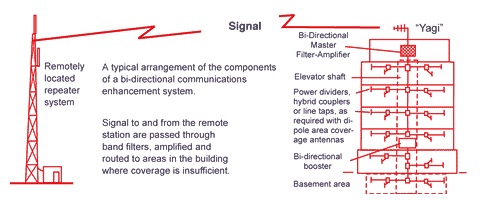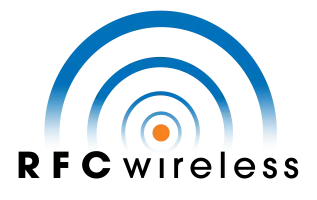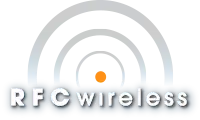In-Building Coverage and Signal Enhancement
Do you need wireless communications inside your building? Do two-way and cellular phones stop working as soon as you walk into your office?
Now the building codes of many worldwide cities require enhancement systems for public safety. Ensuring and extending communications is quickly becoming the rule rather than the exception. RFC offers customized design and implementation to meet these requirements using a variety of products.

Bi-Directional Amplifiers and Distributed Antenna Systems
Radio signals often cannot pass through a building’s structure, particularly if it is made of concrete. This means that trunking systems often suffer intermittent or a complete loss of coverage when going in and out of buildings, tunnels and areas deeply shaded from the base station site. Bi-Directional Amplifiers (BDAs) are signal boosters that sustain two-way radio communications throughout a facility— including in stairwells, underground tunnels, parking garages and other challenging areas. BDAs are amplifiers/repeaters that boost and distribute a signal covering various frequencies. BDAs can be part of a Distributed Antenna System (DAS), which is a network of separate antenna nodes connected to a common transport medium. Collectively, BDA/DAS equipment is often referred to as wireless In-Building Solution. These two-way radio signal boosters are used to bring facilities into compliance with Emergency Responder Radio Coverage (ERRC) code.
The technique/concept of enhanced coverage using directional or bi-directional filter-amplifiers provided a solution to the problem. Placing an antenna array in the clear, aimed at the remote site, provides access to the communications system.
Booster systems have three parts:
- A small antenna mounted on the roof of your building is the booster’s link to the cellular or two-way radio system.
- The booster itself is installed inside a building in a telephone or electrical closet or in some other out-of-the-way location.
- One or more indoor antennas are installed in areas where coverage needs to be improved. These antennas are hidden or installed in an inconspicuous location. The indoor antenna system picks up the signal from your handheld unit and feeds it to the booster, where it is amplified. The amplified signal is fed to the outdoor antenna, which relays it to the nearest cell site.

If visiting customers or your own employees can’t use their two-way radios or cellular phones in your office, a signal booster (also known as a bi-directional amplifier) may be the answer. If your phone or radio works outside your building but goes dead when you go inside, a signal booster system can give you coverage throughout your building. Booster systems can cover one service several. They can also extend your two-way radio system’s coverage into your building.
A distributed antenna system, or DAS, is a network of spatially separated antenna nodes connected to a common source via a transport medium that provides wireless service within a geographic area or structure. DAS antenna elevations are generally at or below the clutter level and node installations are compact. A distributed antenna system may be deployed indoors (an iDAS) or outdoors (an oDAS).
Boosters seamlessly and transparently extend coverage into your office, parking garage, warehouse, basement, or any other area. Users operate their phones just as they do now— the booster is hidden and operates with no attention from the user.




